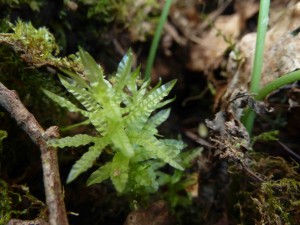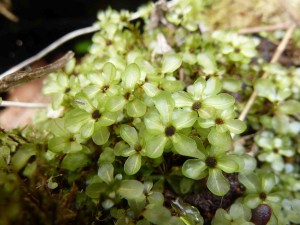
Hello, I’m Julie the new Bryophytes of Scottish Temperate Rainforests Apprentice!
Rainforests? In Scotland!? Yes! We are the lucky occupants of a country inhabited with lush green diverse rainforests! Temperate rainforests enjoy a widespread global distribution, but it is a scarce habitat. Look at a map of the global distribution of temperate rainforest and you will see how lucky we are to reside so close to a habitat that is globally scarce. Britain is also home to over half of the entire European assemblage of known Bryophytes (mosses, liverworts and hornworts)! Not only are we a lucky bunch but I feel we have a duty to admire and protect these plants and their habitats. Feast your eyes on Rhizomnium punctatum and Atrichum undulatum (photos below). These are two of Britain’s most common and widespread species.
Temperate means moderate, therefore a temperate climate, which we all enjoy (wink wink), involves constant moisture and few extremes of temperature, although weather can be rather unpredictable on a daily basis! To be a temperate rainforest requires constant moisture, provided by high annual rainfall (>1400mm) evenly distributed throughout the year, few extremes of temperature with average annual temperature around 4-120C and a relatively dense broad-leaved canopy (>70% cover), meaning that seedlings must be able to regenerate under shade and in natural openings. The influence of the Atlantic means that the west coast of Britain, particularly the western highlands, is one of the wettest places in Europe, keeping average annual rainfall at over 1500mm.
Britain’s temperate rainforests are otherwise known as Atlantic Oakwood or Upland Oakwood and the Bryophyte rich community within them is considered to be among some of the richest in the world. Maintaining the rich diversity of Bryophytes that inhabit these woodlands relies on maintaining microhabitats at a local level (i.e. tree stumps, ravines, rocks are important as many specialized species cannot outcompete the more common species which predominate the ground layer) and connectivity at a landscape level (e.g. recognising where to focus regeneration to allow for the slow and sporadic nature of vegetative propagation that occurs).
Atlantic mosses and liverworts are intriguing because they come from a very ancient lineage. It is a pleasure and a joy to peer through your hand lens at these discrete yet striking plants and (if technically skilled enough!) discover what species they are, helping you to understand what its presence tells you about habitat type and quality. In my own recent, humble, experiences I have been introduced to Plagiochila spinulosa, Scapania gracilis, Hookeria lucens and Metzgeria fruticulosa, which are typical sub-Atlantic species. I feel like I’m name-dropping celebrities! Once I have my eyes trained into and head wrapped around these it is going to be essential to learn of scarcer and rarer Bryophytes, namely those that are strictly ‘Atlantic’ and which identify woodlands of high conservation value. The conservation of Atlantic Oakwood for Bryophytes (and vice versa) is of recognised international importance.
The ability to identify and record Bryophytes of Scottish Temperate Rainforests will enable us to focus our conservation efforts of this habitat against current threats. For example, invasive non-native species, particularly the well-known Rhododendron ponticuum, whose dense bushes shade out and outcompete ground flora and fauna. This is having a significant impact on the health and diversity of our native woodland and subsequently it requires a significant amount of effort to control it. Thorough and continual recording of Bryophytes is a scientifically sound method of planning for conservation management against such a threat to our native woodland.
My placement will initially be based in Edinburgh at the Royal Botanic Gardens, where I will work dutifully to absorb as much knowledge and wisdom as possible from Elizabeth Kungu and David Long, expert Bryologists who will help me to significantly increase my current knowledge of Bryophyte identification! I am absolutely over the moon to have been given this opportunity to learn from Liz and David who are not only experts in their field but are also incredibly passionate about recording and teaching. This apprenticeship will allow me to continue to study Bryophytes at a much more intensive level which is an opportunity I gladly seize with both hands! I would hope that during and following completion of the apprenticeship to a high standard I might begin to be considered a useful addition to current Bryology experts in the field in order to contribute to recording and habitat management.
Throughout 2012 I have attended British Bryological Society (BBS) field meetings in my spare time throughout Dumfries and Galloway and I look forward to continuing to record with the group, and any other groups in Scotland I can feasibly get to! All the recorders on the BBS field meetings are so happy to help people to learn about Bryophytes. I hope to continue to see everyone throughout the coming months.
Now that summer is reluctantly leaving us again (it was 140c and sunny just the other day!) and autumn is properly kicking in, there is no need to hang up the hand lens. Bryophytes are waiting in all their colourful glory all winter. So hand lenses, microscopes and wellies at the ready! Botanising stops for no Bryologist! Yay!


